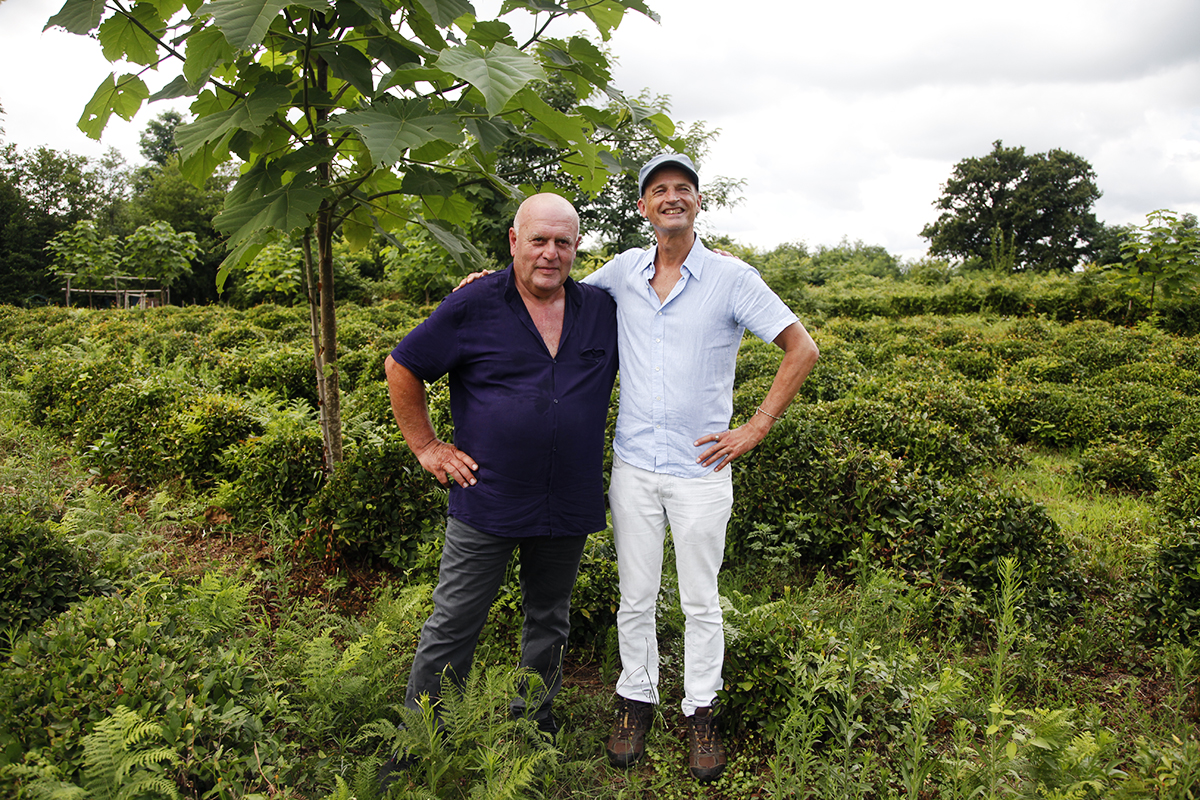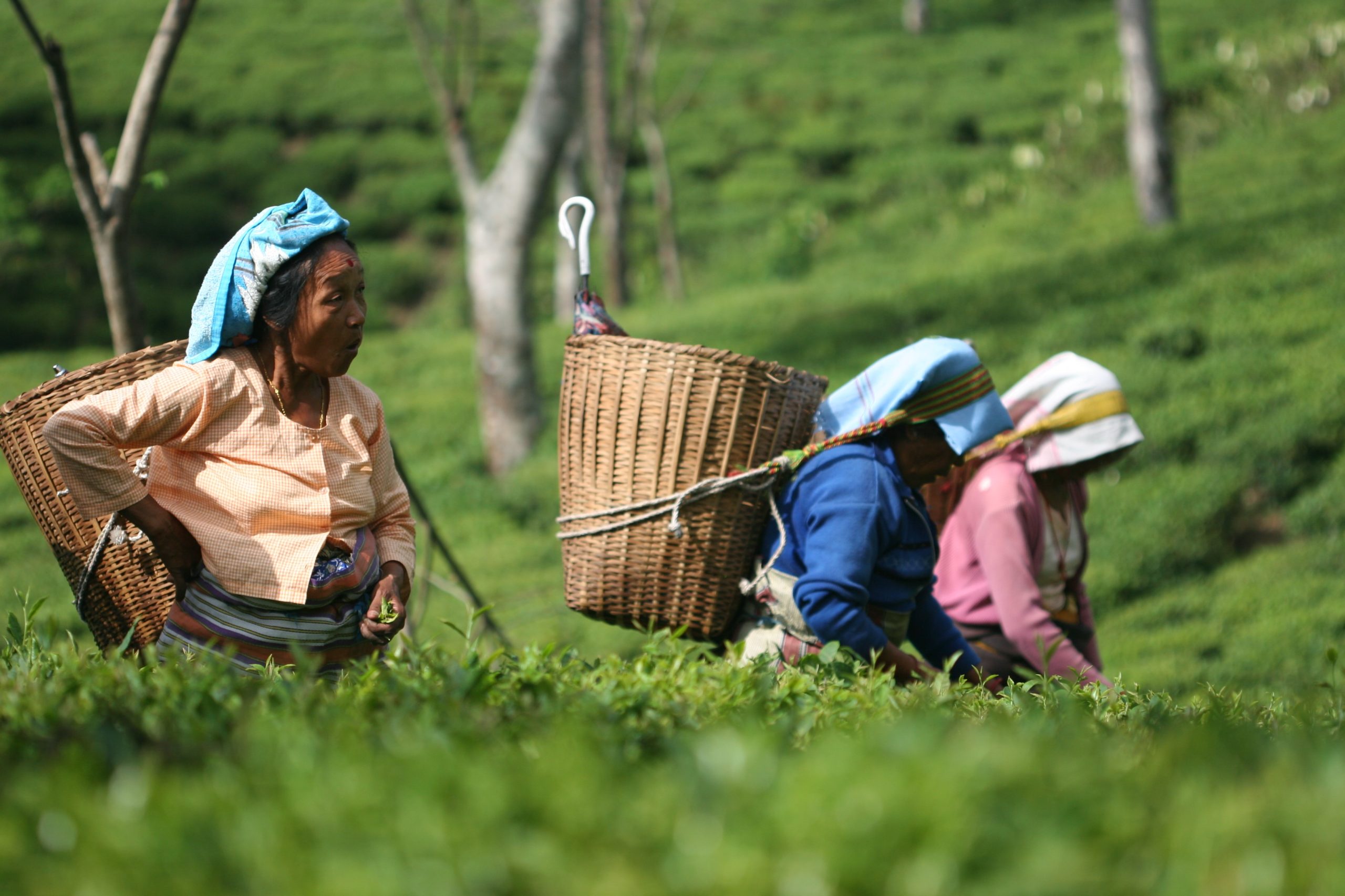Egypt and Morocco are major producers of spearmint, which is the variety used to make their popular mint tea, a symbol of hospitality in North Africa. The mint is harvested using traditional methods and a simple sickle. The bushes are pruned three or four times a year on irrigated land that merges with the desert. Sometimes a motorised machine – a three-wheeled shear with arms and a seat – breaks the silence.
Plantation
Conservation grazing in the Azores
There are many weed control techniques used to keep down plants that grow between the rows of tea bushes. One of the most natural approaches is to let animals graze in the fields. In Southern India, you might come across a type of bison that keeps the farmers happy. Here in the Azores, on the Gorreana plantation, beautiful goats do the job.
A summer break from green to blue
Some tea fields overlook the sea, their green merging into blue. You see this in Japan, for example, as well as in other places around the world like here in the Azores. The blue of a lake that has formed in an ancient crater also makes me think of getting away. I’ve been surrounded by green for most of the year, and now it’s time for me to take some time off I’ll be replacing it with blue. Whatever the colour, I wish you a happy summer and I look forward to being back with you at the beginning of September for new journeys and adventures.
Gorreana and Porto Formosa
There used to be fourteen tea plantations in the Azores; today only two remain. Gorreana is an institution and tourists flock to the factory gates. Everything is original, and it’s not often that a European gets to see the various stages of tea production at first hand. Not far from there, Porto Formosa also welcomes tourists and, as is often the case in the Azores, offers a superb view of the ocean. These old factories mainly produce black tea, but also some green tea. The leaves are harvested by machine. As for the quality of the teas, let’s just say that they are very popular with visitors, who can relive their amazing vacation on this beautiful archipelago every time they brew a cup.
Our Georgian friends
In these difficult times for Georgia, we’ve received this particularly moving message from one of our producer friends: “Every kilo of Georgian tea sold, especially in Europe, contributes to both our dignity and our survival.” Of course, we’re doing what we can for those with whom we work closely, and it’s in this spirit that I’m sharing his message with you. If you’ve never tasted tea from Georgia before, there are some delicious ones. White tea from Guria, for example. The harvest was very small. It’s a white tea produced in the same way as the well-known Bai Mu Dan from China.
In Darjeeling, the first harvests aren’t the best
This year is unlike any other and I have no idea how it will play out in terms of the growing, shipping and availability of premium teas. I’ve just heard from Darjeeling that the very first batch has been harvested. Those of you who’ve been following me for a long time, including fans of first-flush Darjeelings, know that you shouldn’t rush into these things. In this region, the low-altitude plantations are the first to harvest their leaves, as they benefit sooner from milder temperatures. As they warm up, the higher gardens start picking too. The longer the period of dormancy, the slower the sap rises, leading to a greater concentration of essential oils in the leaves. This gives those gardens that harvest later the advantage of quality.
Tea in Brittany
There are attempts to grow Camelia sinensis in many countries, including France. On the banks of the Blavet, near Hennebont (Morbihan), Denis and Weizi are pioneers. They planted eight tea bushes 17 years ago, for their own consumption. They now have 30,000 from 15 different cultivars. Their production is still limited (20 kg per year) but is set to double over the next few years. Denis and Weizi’s enthusiasm is inspiring others to grow tea, and in addition to supplying nearly 20,000 tea plants a year to hobby growers, they are supporting them and forming a strong community.
A taste for creativity
Tea is steeped in tradition, for sure, but innovation is not forbidden. In Tanzania, Bente, who had the audacity to plant tea trees on a coffee plantation, cultivates a taste for creativity. Sometimes she hollows out papayas and fills them with tea so that the camellia leaves take on their aroma when they come into contact with the fruit. At other times, she blows hot air onto sliced bananas, infusing the tea with a new fragrance. And she does everything in the most artisanal way possible. Bravo Bente!
The benefits of passing on your knowledge.
It’s good to learn, but it’s even better if you can pass on your knowledge. I’ve been travelling around the world’s tea gardens for more than 30 years, and during that time I’ve gained enough knowledge that I can share it in my turn. I continue to learn something every day, every time I travel, and I now consider it my primary role to pass on what I’ve learnt. That’s why I ask my colleagues to accompany me on trips, and I plan to do this more. I want them to meet the farmers too, to experience their passion for tea first-hand, to form good relationships with the people who make tea on their mountaintops and who always welcome us with open arms. Here, I’m on the slopes of Kilimanjaro with Chloé and Nathalie and a team of pickers
At the foot of Kilimanjaro
The only plantation in Tanzania that produces teas that can be considered premium is situated an hour’s drive from the town of Moshi. Actually, it’s more of a garden than a plantation. It really is very small, as you can see from the photo. It makes different batches of tea using truly artisanal methods. The factory is run by a woman called Bente. From her house you can enjoy a magnificent view of Kilimanjaro in the early morning or late afternoon.


